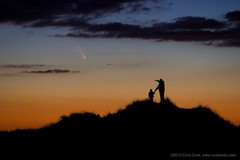(Originally posted on GAM2013 blog)
"When you're in love you want to tell the world. I've been in love with science, so it seems to most natural thing in the world to tell people about it."
- Carl Sagan
...And what more can you ask from an audience than unfaltering enthusiasm and endless curiosity. Take a child out late at night to see a real dark-night sky, and it's an adventure that will stay with them forever.
Between 4 and 10 years is the perfect time for children to get in touch with science for the first time, and astronomy is by far the most inspiring and easy-to-access of all the scientific topics. And research shows that encouraging children to have fun and play while learning, and letting them observe and search for answers themselves, rather than explaining everything, encourages scientific thinking.
Statistics say that for every professional astronomer there are 20 amateurs, and in the last few years the majority are really showing how influential they can be in the scientific community. In recent years, amateur astronomers have stunned the world by beating the professionals ito a number of first discoveries: in 2012, they were the first to detect two strange objects impacting with Jupiter's atmosphere, and more recently, they've spotted dozens of new exo-planets, including many that are possibly habitable! During the International Year of Astronomer in 2009, amateur astronomers played a major role in the organisation of astronomy outreach activities that really brought the global event to life.
Now, Universe Awareness (UNAWE) is inviting amateur astronomers to make a difference by inspiring young children with the wonders of the Cosmos and helping to build a solid future for astronomy and cosmic discovery. You don't have to be a teacher or an expert on pedagogy, just be enthusiastic and let the Universe do the hard work for you!
How can you help with Global Astronomy Month 2013?
Well, you can create an astronomy or astro-photography club at your local primary school and plan some cool observing activities: take the children out to observe the lunar phases or the sunspots. There are loads of activity guides and ideas on our website that can be adapted to fit your own cultural and geographical needs, and for the specific age range you are dealing with.
How to organise
Get in touch with science teachers in local schools and propose some practical activities for students involving observation of the sky. Or if your country is one of 54 with a UNAWE National Programme (find a full list here), you can contact your local UNAWE coordinators to plan activities or just to seek advice and share experiences.
If you can, plan your event around an open day or festivity date and take advantage of similar activities taking place. Try to get friends, colleagues or professors involved to help lighten the workload for yourself (we suggest you aim to have one person for every 15-20 children).
Make sure to take pictures at your activity and we can share them with the community on our international wesbite!
Above all....
- Be enthusiastic
- Keep things simple
- Use analogies
- Encourage Creativity
If you're interested in organising an event and have any questions, need advice or even resources, contact us at info@unawe.org.













